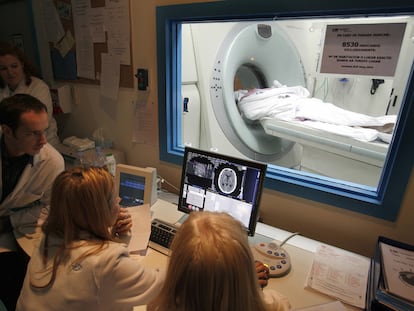One factor reduces by a third the probability of dying after a stroke: social class
People with high incomes have 32% lower risk of mortality after a brain attack, according to a new study, which also looked at the impact of education and country of birth

Having a high income can reduce the possibility of death after a stroke by a third, according to a new study presented on Thursday at the European Stroke Organization Conference. The study analyzed data from 6,901 stroke patients in Gothenburg, Sweden, between November 2014 and December 2019, and examined the impact of four social determinants of health (SDoH): residence, country of birth, education and income.
The results leave no room for doubt: people with a high income have a 32% lower risk of mortality after a stroke. In addition, people with higher education have a 26% lower risk of death after such a brain attack. “Our findings underscore a stark reality — an individual’s socioeconomic status can be a matter of life or death in the context of stroke,” Katharina Sunnerhagen, head of the Rehabilitation Medicine research group at the University of Gothenburg and lead author of the study, explains in an email exchange.
Stroke occurs when blood flow to a part of the brain is blocked or reduced, depriving brain tissue of oxygen. The incidence of these strokes has doubled in the last 30 years and is expected to continue growing, according to a recent study published in The Lancet Neurology. It was warned that the rising incidence would affect countries unevenly, with developing nations expected to be the hardest hit.
But why is money so decisive when it comes to strokes? “We know that wealthier people go to their family doctor more often,” explains Sunnerhagen. “Perhaps people who have a lower income cannot afford to take a leave of absence and lose their salary. In addition, higher income and more education usually mean better eating habits, more physical activity, fewer addictions and less smoking.” All of these are, along with age, the main risk factors for suffering a stroke. Once a person has a stroke, the risk of having another skyrockets.
The study was carried out in Sweden, but the author believes that the results can be extrapolated to the rest of Europe, “where there are similar health structures and levels of social vulnerability.” This, she explains, highlights “a widespread problem across the continent.”
Mari Mar Freijo, coordinator of the SEN Cerebrovascular Diseases Study Group, agrees with this reading. She points to the latest Annual Report of the Spanish National Health System, where it is noted that “for cerebrovascular disease, a social gradient is observed with an increase in prevalence as the level of income decreases.” Social context and economic and educational level are determining factors when it comes to the risk of having a stroke. “The same thing happens once you have suffered a stroke,” she adds by phone. “Controlling risk factors is very important to prevent these events from recurring.”
Freijo believes that the Swedish study provides more evidence to support an idea that has been gaining traction in recent years. Cerebrovascular events are, in large part, caused by lifestyle. This has a negative side: it makes inequalities and poverty a determining factor. But it has a positive side, because these diseases are largely preventable. “Policies aimed at health promotion and primary prevention, so that a vascular event does not occur, are very important,” says the neurologist.
In addition to identifying a significant connection between income and risk of mortality after stroke, the study points to a worrying trend regarding the cumulative impact of SDoH. These determinants, according to the WHO, “are the circumstances in which people are born, grow, work, live and age.” Their social context. In the present study, patients with one unfavorable SDoH had an 18% higher risk of mortality compared to patients without any unfavorable SDoH factors. This risk increased to 24% in patients with between two and four SDoH factors. When analyzing risk factors, it is not only cholesterol, alcohol consumption or smoking that must be taken into account, but also a person’s zip code.
When examining gender differences and the potential impact of SDoH factors, it was seen that the proportion of women increased with the number of unfavorable SDoH factors; 41% of the group with no unfavorable SDoH factors were women, while 59% of the group with two to four unfavorable SDoH factors were women. “It increased considerably,” says Sunnerhagen, “which is one of the most interesting findings.” A social inequality that translates into greater health risk.
The study also points out that it is essential to have specific strategies. “Policymakers, for instance, must tailor legislation and approaches to account for the specific circumstances and needs of diverse communities,” states Sunnerhagen, in the press release to announce the findings. “While clinicians should consider identifying patients with unfavorable SDoH factors to prevent post-stroke mortality.”
In Sweden, the incidence of ischemic stroke has decreased, meaning the number of strokes is lower despite the population being older. “This has to do with prevention, with the low level of smoking in the country, controlled hypertension, good diabetes care... And also with reducing the number of sedentary people,” explains Dr. Sunnerhagen. According to the expert, the only risk factor that cannot be controlled is age, and that despite the impact of social conditions and external factors, the disease must begin to be treated through prevention. “The best stroke is the one you don’t have.”
Sign up for our weekly newsletter to get more English-language news coverage from EL PAÍS USA Edition
Tu suscripción se está usando en otro dispositivo
¿Quieres añadir otro usuario a tu suscripción?
Si continúas leyendo en este dispositivo, no se podrá leer en el otro.
FlechaTu suscripción se está usando en otro dispositivo y solo puedes acceder a EL PAÍS desde un dispositivo a la vez.
Si quieres compartir tu cuenta, cambia tu suscripción a la modalidad Premium, así podrás añadir otro usuario. Cada uno accederá con su propia cuenta de email, lo que os permitirá personalizar vuestra experiencia en EL PAÍS.
¿Tienes una suscripción de empresa? Accede aquí para contratar más cuentas.
En el caso de no saber quién está usando tu cuenta, te recomendamos cambiar tu contraseña aquí.
Si decides continuar compartiendo tu cuenta, este mensaje se mostrará en tu dispositivo y en el de la otra persona que está usando tu cuenta de forma indefinida, afectando a tu experiencia de lectura. Puedes consultar aquí los términos y condiciones de la suscripción digital.
More information
Archived In
Últimas noticias
NASA discovers Titan doesn’t have an ocean, but a ‘slushy ice layer’ that increases possibility of life
Innocence lost in the forest of the child soldiers: ‘Each leader of the armed group had his girls’
‘Fallout’ or how the world’s largest company turned an anti-capitalist apocalyptic Western into a phenomenon
From inflation to defending migrants: Eileen Higgins and Zohran Mamdani inaugurate the new Democratic resistance against Trump
Most viewed
- Christian Louboutin: ‘Young people don’t want to be like their parents. And if their parents wear sneakers, they’re going to look for something else’
- ‘El Limones’ and the growing union disguise of Mexican organized crime
- The low-cost creative revolution: How technology is making art accessible to everyone
- ‘We are dying’: Cuba sinks into a health crisis amid medicine shortages and misdiagnosis
- Liset Menéndez de la Prida, neuroscientist: ‘It’s not normal to constantly seek pleasure; it’s important to be bored, to be calm’











































